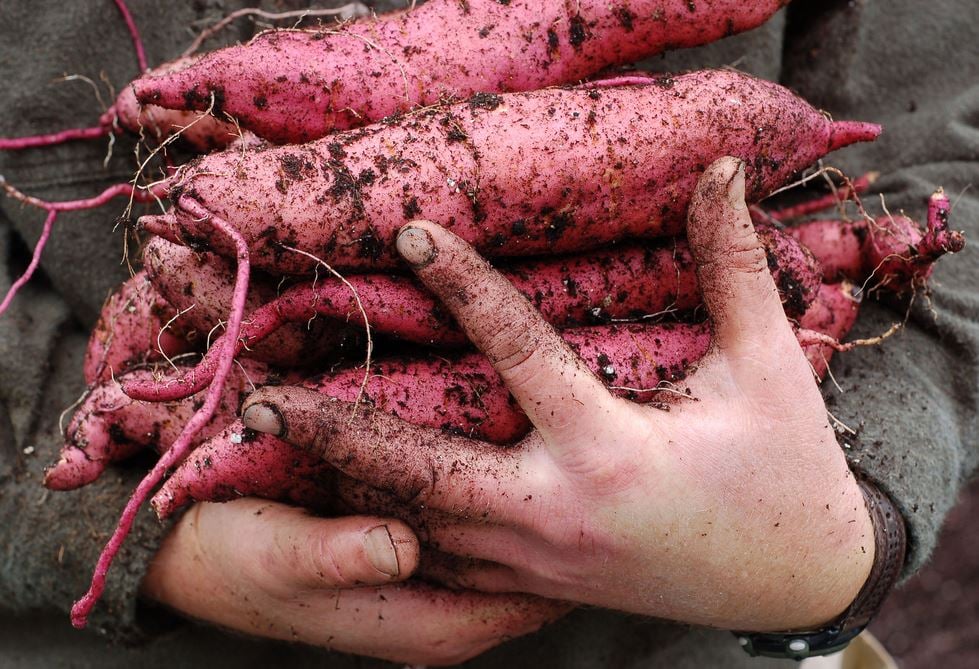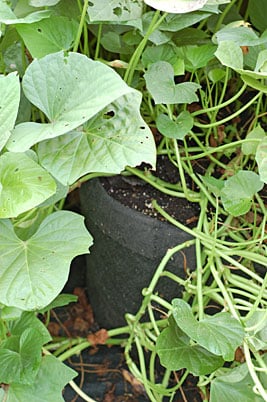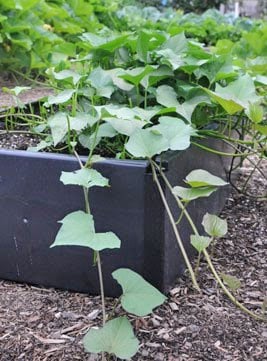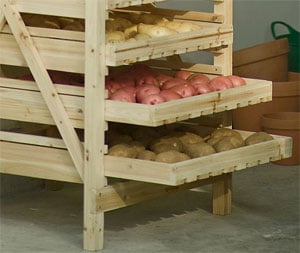Sweet Potatoes
 Sweet potatoes, just harvested.
Sweet potatoes, just harvested.Like regular potatoes, sweet potatoes are starchy tubers that form underground. But the heart-leafed vine that produces sweet potatoes requires a longer growing season (100 to 140 days) and warmer soil than the kind of plant that produces regular "white" potatoes. Until recently, that's made them almost impossible to grow in the colder parts of the country. Now, with short-season sweet potato varieties, such as Georgia Jet, and soil-warming growing techniques, gardeners everywhere can enjoy growing this easy and delicious crop.

When you plant regular potatoes, you simply bury pieces of potato from last year's crop. Sweet potatoes are grown from "slips," which are rooted sprouts from mature tubers. These tender, rooted sprouts can be purchased by mail or sometimes as potted plants at a garden center. The Steele Plant Company is one popular mail-order source for slips.
Sweet potato plants are sensitive to cold, so they should not be planted outdoors until the soil has warmed to at least 60 degrees F. and nighttime temperatures are above 60 degrees F. To help warm the soil, spread black plastic over the planting area for a couple weeks before planting.
Newly-planted sweet potato slips should be protected from cool spring nights. For the first three to four weeks after planting, keep the plants covered with garden fabric to reduce stress and speed early growth.
Don't fertilize your sweet potatoes at planting time — they don't require much in the way of nutrients. An excess of nitrogen will encourage leafy growth rather than big tubers.
The best soil for sweet potatoes is loose and rich in organic matter. In the garden, mix some well-aged compost into each planting hole and then plant slips 12-18" apart, burying the stem with soil right up to the first pair of leaves. If you are growing sweet potatoes in Grow Bags, fill the bags with Container Mix, and then add a shovelful of compost and about half a cup of granular organic fertilizer.
 Sweet potatoes thriving in a Grow Bag.
Sweet potatoes thriving in a Grow Bag.Mulching sweet potato plants with black plastic helps keep the soil as warm as possible. It also prevents the vines from setting down more roots as they grow, which takes energy from tuber formation. If you are not using plastic, lift the vines from time to time to break off the roots that form along the stem.
The foliage on regular potato plants tends to die back when the spuds are ready to harvest. Sweet potato plants keep on growing until the temperatures get too chilly. Let them grow as long as possible (at least 120 days), but be sure to harvest the tubers before the first heavy frost. Cold temperatures can damage the sensitive tubers. You'll find sweet potatoes are easier to dig than regular potatoes because the tubers tend to cluster more closely to the stem. As you harvest, treat the tubers gently because the skin is thin and the flesh bruises easily.
 Sweet potatoes growing in a Grow Bed.
Sweet potatoes growing in a Grow Bed.Once harvested, let your sweet potatoes air dry for several hours, then nestle them into a shallow basket or ventilated box, lined with dry newspaper. The tubers should then be "cured" for 10 to 15 days at 80 to 85 degrees (a warm, dark attic is ideal). The optimum temperature range for storage after curing is 55 to 60 degrees.
 Under ideal conditions, sweet potatoes can be stored in an Orchard Rack, which is made for storing all kinds of "keeper crops."
Under ideal conditions, sweet potatoes can be stored in an Orchard Rack, which is made for storing all kinds of "keeper crops."Last updated: 01/29/2021
Print this Article:
Get the Dirt
Stay up to date on new articles and advice. Please fill out the information below.
